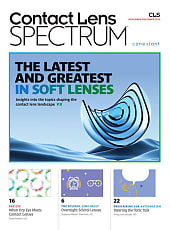Presbyopia management is comprised of a wide range of tools to meet evolving needs and lifestyles. Success comes from knowing these options exist, understanding how to use each one effectively, and recognizing how patient complaints point to the right solution(s).
Spectacle Lenses
Progressive lenses should be the starting point due to the range of vision they provide and advanced digital-surfacing technologies. Today’s designs offer smooth transitions, wide fields of view, and the ability to fine-tune specific zones—making them adaptable for patients who have a range of visual demands, from office work, to daily multitasking.
For those who spend long hours in front of screens, task-specific options, like workspace lenses, are essential. These designs prioritize intermediate and near zones to reduce digital eye strain, improve ergonomics, and enhance comfort throughout the day.
Not every patient adapts easily to traditional progressives. That’s where antifatigue lenses are a valuable alternative. With a primary focus on distance clarity and a gentle near boost, they provide functional support without the complexity of a full-progressive design.
Single-vision readers and bifocals still have a role here. Our goal is to understand each patient’s daily demands and offer the right combination of lens designs to support those needs.
Contact Lenses
Despite their benefits, many patients remain unaware that contact lenses are an option for presbyopia. While presbyopic fittings may require more chair time (averaging 2.6 attempts), only 12% ultimately reject the modality.1
In practice, 51% of patients choose multifocal lenses, while 37% prefer monovision correction.1

Ideal candidates include those who have high myopia, hypermetropia, or anisometropia over 2 D, where glasses often cause distortion or discomfort. Monovision may also help reduce diplopia, while maintaining functional acuity.
For patients who have irregular corneas or specific visual demands, gas permeable, scleral, or hybrid lenses can offer superior optics in both monovision and multifocal designs.
Multifocal and monovision orthokeratology can give patients nonsurgical freedom from daytime correction.
Eye Drops
These offer a novel, noninvasive option for those who don’t want to commit to glasses or contact lenses. They are ideal for patients who have mild near-vision deficits, value convenience, and are seeking an on-demand solution for tasks, such as reading menus.
Surgery
Surgical options continue to evolve, offering long-term solutions. Presbyopic LASIK, intracorneal inlays, and advanced intraocular lens implants can reduce or eliminate dependence on glasses across multiple distances. ODs play a key role in identifying candidates, educating them on the related risks and benefits, and coordinating comanagement to ensure optimal outcomes.
Make It Personal.
The best treatment is a personalized one. As optometrists, we have the tools to deliver care that is functional, empowering, and transformative—enhancing not just vision, but quality of life.
Reference
1. Woods J, Woods C, Fonn D. Visual Performance of a Multifocal Contact Lens versus Monovision in Established Presbyopes. Optom Vis Sci. 2015;92(2):175-182. doi:10.1097/OPX.0000000000000476.




